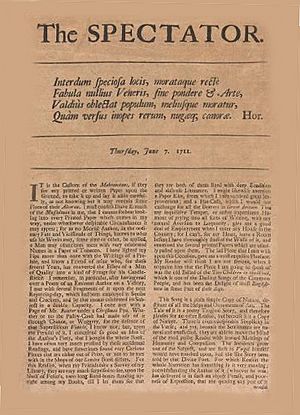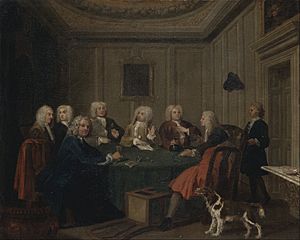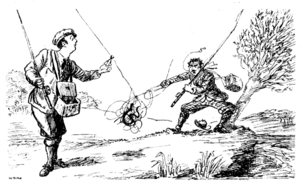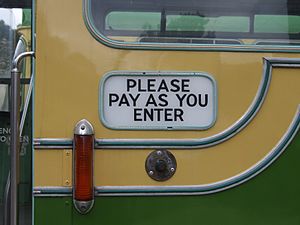Politeness facts for kids
Politeness means being kind and respectful to others. It's about using good manners so you don't upset anyone. What is considered polite can be very different depending on where you are in the world. Something polite in one country might be rude in another!
The main goal of politeness is to help everyone feel comfortable. It makes social interactions smoother and more pleasant. However, sometimes people might use politeness in tricky ways.
Contents
Types of Politeness
Scientists who study cultures, like Penelope Brown and Stephen Levinson, have found two main types of politeness. These ideas come from Erving Goffman's concept of "face", which means how we want others to see us.
- Negative Politeness: This type of politeness respects a person's freedom. It's about not forcing someone to do something. For example, you might say, "If you don't mind..." or "Would it be too much trouble if...?" This shows you respect their choice. It's like being very careful and respectful.
- Positive Politeness: This type of politeness helps build a good relationship. It shows you like and understand the other person. Sometimes, it can even involve using informal language or jokes. This shows that your relationship is strong enough to handle things that might usually seem impolite. It also shows you care about their feelings and values.
Different cultures often prefer one type of politeness over the other. This is why politeness is so connected to culture.
A Brief History of Politeness

During the Enlightenment era (a time of new ideas in the 1700s), being polite became very important. It was a sign that you belonged to the upper class. People from the middle class wanted to be seen as fancy too. They started to copy the manners and artistic tastes of the rich.
They became very focused on rules for how to act. This included how to show feelings, dress well, have graceful conversations, and be polite, especially to women. A philosopher named Lord Shaftesbury wrote essays about politeness. He said politeness was the art of being pleasant to others.
He wrote that politeness is "a clever way of managing our words and actions. It makes other people think better of us and themselves."

Newspapers and magazines also helped teach politeness. The Spectator, started in 1711, gave daily advice on how to be a polite gentleman. Its goal was to mix good morals with cleverness. It wanted to bring serious ideas into everyday places like clubs and coffeehouses. It gave readers interesting topics to talk about. It also taught them how to have polite conversations.
Coffeehouses were popular places for polite talks and debates. People were expected to speak in a civil and reasoned way. Rules for good behavior were set by groups like gentlemen's clubs. Magazines like The Tatler and The Spectator helped spread these polite ways of talking in English coffeehouses.
Politeness Techniques
People use different techniques to be polite:
- Being Unsure: Sometimes, people use words that make what they say less direct. This is called "hedging." For example, saying "It might be a good idea" instead of "It is a good idea."
- Polite Lies: Sometimes, people tell a small lie to avoid hurting someone's feelings. This is called a polite lie.
- Softer Words: Using euphemisms means using milder words for something that might be unpleasant. For example, saying "passed away" instead of "died."
- Tag Questions: These are small questions added to the end of a statement. For example, "You were at the store, weren't you?"
- Modal tags ask for information you're not sure about: "You haven't been to the store yet, have you?"
- Affective tags show you care about the listener: "You haven't been here long, have you?"
- Softeners make a request less demanding: "Hand me that thing, could you?"
- Facilitative tags invite the other person to comment: "You can do that, can't you?"
Some studies suggest that girls and women might use polite language more often than boys and men. However, the differences are not always clear. It seems that politeness is often linked to how middle-class women are expected to speak in some cultures. This might be why women are often seen as more polite.
Politeness in Language
Many languages have special ways to show politeness, respect, or to recognize someone's social status.
- Word Choice: Some languages use different words for formal and informal situations.
- Verb Forms: Some languages change how verbs look to show politeness. For example, in many European languages, there are different ways to say "you" (like "tu" and "vous" in French).
- Avoiding Pronouns: Some Asian languages avoid using "you" altogether to be more polite.
Languages like Korean and Japanese have very complex politeness systems.
Different Views on Politeness
The ideas about politeness from Brown and Levinson have been questioned. Some linguists who study East Asian languages, like Japanese, say their theory doesn't always fit. They argue that in cultures like Japan, politeness isn't just about what a speaker chooses to say. Instead, it's about knowing your place (called wakimae) and following social rules. Wakimae means understanding your role and acting in a way that fits the situation.
Japanese is a great example of a language where politeness is built into its core. It has two main levels of politeness: one for close friends and family, and another for other groups. Verbs change depending on the politeness level. Some verbs even have super-polite forms. Japanese also uses different personal pronouns (like "I" or "you") based on gender, age, rank, and how well you know someone.
See also
 In Spanish: Cortesía para niños
In Spanish: Cortesía para niños
- Courtesy
- Etiquette
- Formality
- Intercultural competence
- Polite fiction
- Politeness maxims (Geoffrey Leech)
- Politeness theory
- Register (sociolinguistics)
- Respect
- Valediction



